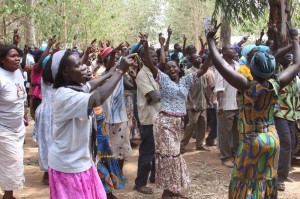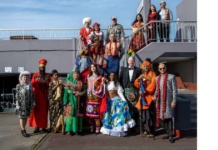The Lango are probably decedents of the Nilotic people. It is hypothesized in the fifteenth century that they migrated to their current location as part of the southerly migration of the Nilotic. In the mid-nineteenth century the Lango and many other non Bantu tribes were overlooked for colonial development by the British because they were stateless and the British wanted to focus on the more organized Bantu tribes. This led to the “Bantu line” where non-Bantu were above. This exclusion lead to distrusts and between the Lango and Ganda(a Bantu tribe colonized by the British), that exists even today even until the 1970s where the two organized themselves into political parties. The result of this was “guerrilla skirmishes and a series of opposition movements”-everyculture.com. In short this has left the Lango with very little political power and economic hardship.
The Lango practice polygyny and attach considerable importance to bride-wealth. Men commonly extol polygyny as an ideal, but in the 1960s only about 20 percent of the men who were married at any given time were married polygynously. Men commonly find it difficult to arrange for the bride-price for a second wife, and many women do not want to be married as a second or subsequent wife; hence, polygynous marriages are not always possible. Another important factor is population pressure. In some locales, there is not enough land available for men to have more than one wife, given the fact that men are expected to provide all of their wives with fields of approximately equal size for cultivation.
One of the difficulties in polygynous marriages is the relationship between co-wives. A woman who allows her husband to marry a second wife often does so with the expectation that she will have some authority over the junior wife; thus the junior wife enters the marriage in a weak position. A woman who has failed to bear children in a previous marriage or who has the reputation of being troublesome or lazy is more willing to be married polygynously. Such a woman also commands a relatively lower bride-price.
The bride-price in Lango is about fourteen head of cattle and a significant amount of other goods such as goats, cloth, cooking pots, and hoes, which are paid to the family of the bride. The problem of accumulating the bride-price can be very complicated, and boys must start planning how to solve it during their adolescence. A boy may obtain the support of his mother, who will attempt to get some of the cattle from her husband’s herd for the boy’s bride-price. Boys also are linked to their sisters; they must wait until their sisters are married so that they can obtain part of their bride-prices to pay for their own marriages. One other possibility is for boys to solicit cattle from members of their lineage or from their mothers’ brothers. A kinsman who sponsors a marriage may expect the young man to reside near him after marriage and to serve as his dependent. Thus, men who have no sons sometimes acquire the loyalty of young members of their own lineage by sponsoring their marriages. If a man sponsors the marriage of his sister’s son, the children born to the marriage will belong to the lineage of the sponsor (i.e., they will belong to the descent group of their father’s mother’s brother). This, of course, is a deviation from the normally strict rule of patrilineal descent, but the Lango see this arrangement as entirely consistent. They say that a child belongs to the descent group of the person who paid the bride-wealth of its mother. Normally, a woman’s husband receives the bride-price from his own descent group, and a boy is discouraged from asking his mother’s brother for bride-wealth. Children born to a woman for whom no bride-wealth has been paid belong to their mother’s descent group (i.e., the descent group of her father). If a man subsequently marries the woman by paying bride-wealth, he may pay an additional amount to her father and procure her children for his own descent group. Because of the difficulty that is encountered in paying bride-wealth, a young man cannot reasonably expect to be married before he is 21, whereas girls commonly marry at about age 16.
Lango religious beliefs are very diffuse and have been affected by the introduction of Christianity as well as by contact with neighbouring societies. The Lango believe in a creator spirit called Jok, who is regarded as an all-powerful deity, and who is often equated with the Judeo-Christian God of the missionaries. There are also lesser deities—the spirits who bring sickness and cause trouble; the term for these deities is also “jok.” These spirits are of two sorts. The first, associated with the wind, are seen as free-floating spirits who dwell in out-of-the-way places and attack people, often for no good reason. They are harmful and capricious, and people believe that it is important to take precautions against them. The other sort of jok is the shadow, or soul, of a deceased person.
Most Lango ceremonies are either rites of passage or rituals associated with problems of spirit possession and fertility. Beginning around 1920, rituals that centred on spirit possession spread from the neighbouring Bunyoro people into the western part of Lango District. The spirit-possession rituals had great appeal to women, and women were predominant in many of the possession activities, both as patients and as the principal performers. As possession rituals became more popular in the 1940s and the 1950s, the traditional rituals, which had mostly been performed by men, began to decline. Younger men lost interest in the traditional rituals, which came to be held less often. Since the 1960s, women have been more active than men in performing rituals, most of which involve an attempt to cure someone—typically, a woman—who is believed to have been possessed by a spirit.
Music and dance are important aspects of Lango life; the finger piano, drum, and flute are the principal instruments. Singing is done mostly by women, some of whom are recognized as virtuoso solo singers, but groups of people also enjoy singing in unison. Groups of young people compete with one another in public dance contests.











